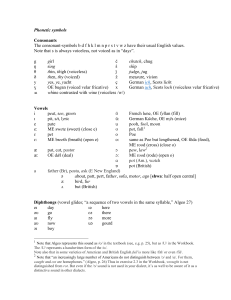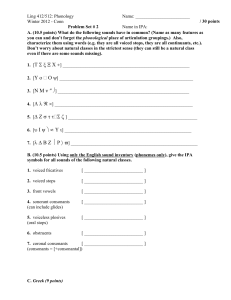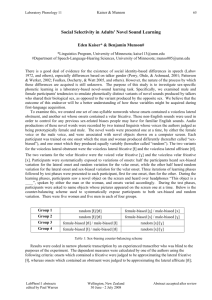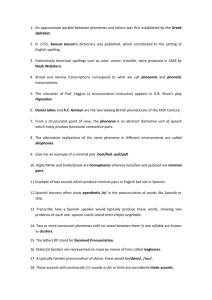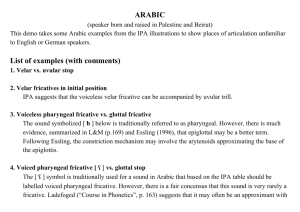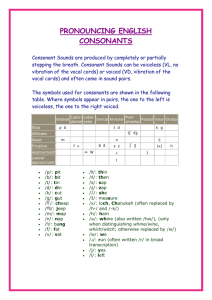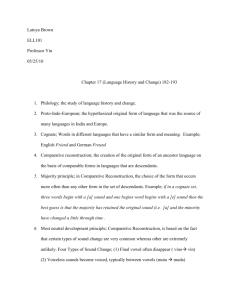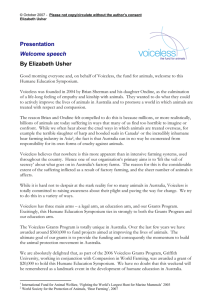PP13_10_phonology II
advertisement
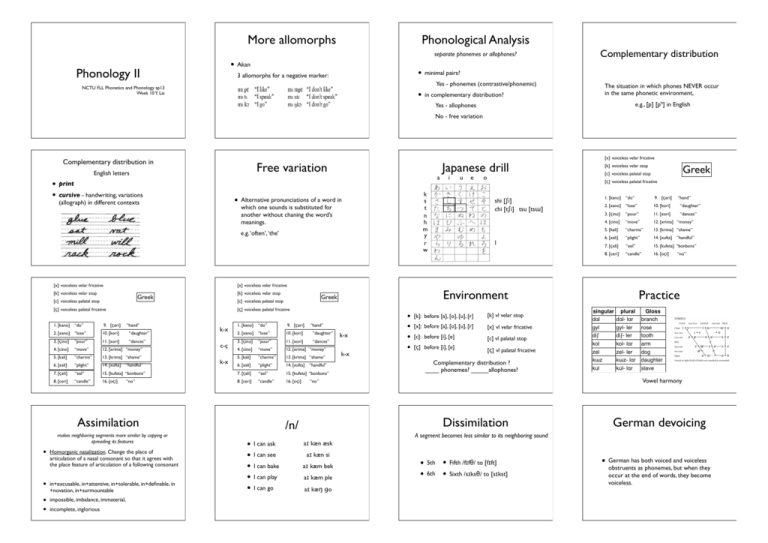
More allomorphs Phonological Analysis Complementary distribution separate phonemes or allophones? • Akan Phonology II • minimal pairs? 3 allomorphs for a negative marker: Yes - phonemes (contrastive/phonemic) NCTU FLL Phonetics and Phonology sp13 Week 10 Y. Lai The situation in which phones NEVER occur in the same phonetic environment, • in complementary distribution? e.g., [p] [ph] in English Yes - allophones No - free variation Complementary distribution in Free variation English letters • • cursive - handwriting, variations a print which one sounds is substituted for another without chaning the word’s meanings. e.g. ‘often’, ‘the’ [x]!voiceless velar fricative [x]!voiceless velar fricative [k]! voiceless velar stop [k]! voiceless velar stop Greek [c] !voiceless palatal stop [ҫ]!voiceless palatal fricative [ҫ]!voiceless palatal fricative 1. [kano]! “do”! ! ! 9. [ҫeri] 2. [xano]! “lose”! ! ! 10. [kori]! “daughter” 3. [ҫino]! “pour”!! ! 11. [xori]! “dances” 4. [cino]! “move”! ! 12. [xrima] “money” “charms”! ! 13. [krima] “shame” 5. [kali] ! “hand” “handful” k-x c-ç k-x 1. [kano]! “do”! ! ! 9. [ҫeri] 2. [xano]! “lose”! ! ! 10. [kori]! “daughter” 3. [ҫino]! “pour”!! ! 11. [xori]! “dances” 4. [cino]! “move”! ! 12. [xrima] “money” “charms”! ! 13. [krima] “shame” 5. [kali] ! ! 14. [xufta] 6. [xali] ! “plight”! ! 14. [xufta] 7. [ҫeli]! “eel”! ! ! 15. [kufeta] “bonbons” 7. [ҫeli]! “eel”! ! ! 15. [kufeta] “bonbons” 8. [ceri]! “candle”! ! 16. [oҫi] 8. [ceri]! “candle”! ! “no” Assimilation makes neighboring segments more similar by copying or spreading its features • “hand” 6. [xali] ! “plight”! Homorganic nasalization. Change the place of articulation of a nasal consonant so that it agrees with the place feature of articulation of a following consonant • in+excusable, in+attentive, in+tolerable, in+definable, in +novation, in+surmountable • • impossible, imbalance, immaterial, incomplete, inglorious 16. [oҫi] “handful” u e k-x k-x • • • • [ҫ]!voiceless palatal fricative shi [ʃi] chi [tʃi] tsu [tsɯ] 1. [kano]! “do”! ! ! 9. [ҫeri] 2. [xano]! “lose”! ! ! 10. [kori]! “daughter” 3. [ҫino]! “pour”!! ! 11. [xori]! “dances” 4. [cino]! “move”! ! 12. [xrima] “money” “charms”! ! 13. [krima] “shame” 5. [kali] ! l [k]:! before [a], [o], [u], [r] [k] vl velar stop [x]:! before [a], [o], [u], [r] [x]! vl velar fricative [c]:! before [i], [e] [c] vl palatal stop [ҫ]! before [i], [e] Greek [c] !voiceless palatal stop o [ҫ]! vl palatal fricative Complementary distribution ? ____ phonemes? _____allophones? “hand” 6. [xali] ! “plight”! ! 14. [xufta] 7. [ҫeli]! “eel”! ! ! 15. [kufeta] “bonbons” 8. [ceri]! “candle”! ! 16. [oҫi] “handful” “no” Practice singular plural Gloss dɑl gyl dɑl- lɑr gyl- ler branch rose diʃ kol zel diʃ- ler kol- lɑr zel- ler tooth arm dog kɯz kul kɯz- lɑr kul- lɑr daughter slave Vowel harmony “no” Dissimilation /n/ • I can ask • I can see • I can bake • I can play • I can go i [k]! voiceless velar stop Environment Greek [c] !voiceless palatal stop Japanese drill k s t n h m y r w • Alternative pronunciations of a word in (allograph) in different contexts [x]!voiceless velar fricative German devoicing A segment becomes less similar to its neighboring sound aɪ kæn æsk aɪ kæn si aɪ kæm bek aɪ kæm ple aɪ kæŋ ɡo • 5th • Fifth /fɪfθ/ to [fɪft] • 6th • Sixth /sɪksθ/ to [sɪkst] • German has both voiced and voiceless obstruents as phonemes, but when they occur at the end of words, they become voiceless. Distinctive Features • For two phones/sounds, to contrast meaning there must be some difference b/t them e.g., the phonetic feature of voicing Feature values • [+ feature] or [-feature] to indicate the presence or absence of that particular feature • e.g., [b] is [+voiced] and [p] is [-voiced] distinguishes [s] from [z] Feature values • [+ feature] or [-feature] to indicate the presence or absence of that particular feature • e.g., [b] is [+voiced] and [p] is [-voiced] What are YOUR distinctive features? • When a feature distinguishes one phoneme from another, it is a distinctive feature or a phonemic feature Features in ASL • Signs can also be broken down into features: • The location, movement, and handshape are distinctive features • Minimal pairs can be found to prove that these features are distinctive • There are also nondistinctive features of ASL such as whether a sign is articulated with the right or the left hand Natural Classes Phonological rule Greek • Phonological rules often apply to natural classes of sounds • A natural class is a group of sounds described by a small number of distinctive features • Natural classes can be defined by + and – feature values • Palatalize velar consonants before front vowels [+velar] ! [+palatal] / ___ [-back]
